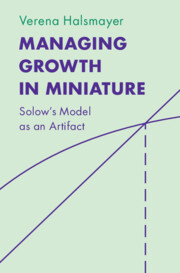Book contents
- Managing Growth in Miniature
- Historical Perspectives on Modern Economics
- Managing Growth in Miniature
- Copyright page
- Contents
- Figures
- Introduction
- 1 The Artifact and the Experimental Report
- 2 The Problematic of Growth and Productivity
- 3 Modeling the Economic System
- 4 Growth in Miniature
- 5 Model Talk
- Epilogue
- Acknowledgments
- References
- Index
- Series page
4 - Growth in Miniature
Published online by Cambridge University Press: 24 October 2024
- Managing Growth in Miniature
- Historical Perspectives on Modern Economics
- Managing Growth in Miniature
- Copyright page
- Contents
- Figures
- Introduction
- 1 The Artifact and the Experimental Report
- 2 The Problematic of Growth and Productivity
- 3 Modeling the Economic System
- 4 Growth in Miniature
- 5 Model Talk
- Epilogue
- Acknowledgments
- References
- Index
- Series page
Summary
Chapter 4 situates Solow’s model in the heterogenous landscape of mathematical economics in the early 1950s. Robert Solow got acquainted with different strands of structuralist and mathematical reasoning before he devised the model more or less incidentally in the context of teaching engineering students at MIT. Here, I describe Solow’s model as a miniature not of the world but of other models. Its smaller scale and reduced mathematical form fit older mathematical economics while, at the same time, it related to the more sophisticated systems of proof and proposition characteristic of general equilibrium theory. While rigor and axiomatization also played a role in the construction of the miniature, the related style of modeling did not revolve around the austere beauty of proposition and proof. Rather, it centered on creating simple and manageable artifacts that upheld the promise of being useful tools for economic governance. The efficient shape of Solow’s model made it a particularly talkative artifact. Not least, it provided a starting point for a number of stories, including what economists themselves called “fables” or “parables” about growth.
Keywords
- Type
- Chapter
- Information
- Managing Growth in MiniatureSolow's Model as an Artifact, pp. 141 - 178Publisher: Cambridge University PressPrint publication year: 2024

